
Buy flame-retardant plastic sheets cut to size
Depending on the fire protection requirements, the use of fire-resistant materials may be necessary. It is not uncommon to choose plastic sheets, of which there is a whole range of plastics that are classified as flame-retardant.
- We offer you flame-retardant plastic sheets for almost all applications
- We also carry transparent, conductive and food-safe plastics with low flammability
- We offer a wide range of thicknesses, colours and formats for fire-resistant plastics
PETG Sheets transparent 2x1 meter
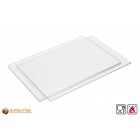 from €19.90 / pcs
from €19.90 / pcsIncl. 19% Tax
Hard-PVC sheets darkgray custom cut
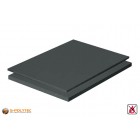 from €17.87 / m2
from €17.87 / m2Incl. 19% Tax
Hard-PVC sheets black 2x1 meter
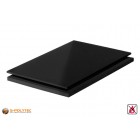 from €19.15 / pcs
from €19.15 / pcsIncl. 19% Tax
Hard-PVC sheets red 2x1 meter
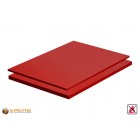 from €31.81 / pcs
from €31.81 / pcsIncl. 19% Tax
Hard-PVC sheets darkgray 2x1 meter
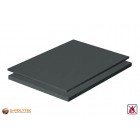 from €15.43 / pcs
from €15.43 / pcsIncl. 19% Tax
Hard-PVC sheets white 2x1 meter
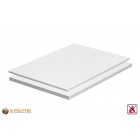 from €15.43 / pcs
from €15.43 / pcsIncl. 19% Tax
Hard-PVC sheets transparent 2x1 meter
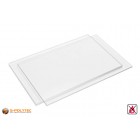 from €26.78 / pcs
from €26.78 / pcsIncl. 19% Tax
Hard-PVC sheets light grey 2x1 meter
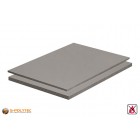 from €13.47 / pcs
from €13.47 / pcsIncl. 19% Tax
Trespa® Meteon® FR UNI COLOURS 2x1meter
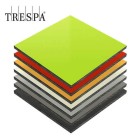 from €271.50 / pcs
from €271.50 / pcsIncl. 19% Tax
HPL sheets wood decor (dark ash)
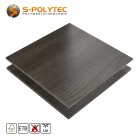 from €74.11 / m2
from €74.11 / m2Incl. 19% Tax
HPL sheets vintage look (oak white)
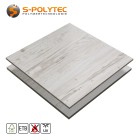 from €74.11 / m2
from €74.11 / m2Incl. 19% Tax
HPL sheets anthracite (RAL7016)
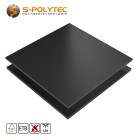 from €62.16 / m2
from €62.16 / m2Incl. 19% Tax
Flame resistant plastic sheets
Refractory plastics - The right panel for every requirement
There are countless examples of the use of fireproof plastic panels, or areas of application in which the fire behaviour of a plastic panel is decisive. Especially in the construction industry, strict requirements apply to building materials. Particular attention is paid to fire protection in industry or areas open to the public, such as airports, public authorities, shopping centres or shops. Also in public transport, strict standards and regulations must be observed. This does not basically apply only to plastics, but flame-retardant plastics can be used to advantage in many areas because they are very easy to process and have a low weight compared to other materials.
As versatile as the areas of application are, our range of flame-retardant plastics is just as extensive.
We at S-Polytec offer you the right plastic for almost any application, either as a cut-to-size panel or as a standard panel in many thicknesses, colours and designs. From transparent plastics as a fireproof glass substitute, to flame-retardant plastic sheets with food approval or facade sheets according to DIN 4102 B1, no wish remains unfulfilled. Even impact-resistant plastics or electrically conductive plastics, we can deliver in flame-retardant versions quickly and at a reasonable price.
Typical applications for flame-retardant plastic sheets
Which plastic is suitable for which application depends not least on the specific requirements for the properties. If high light transmission is required, transparent PETG can be used as well as PVC glass made of rigid PVC or polycarbonate. If a high level of stability and rigidity is required for the construction of balcony cladding, HPL is most suitable, provided the HPL sheets have the necessary balcony approval in accordance with the ETB directive. This also applies to the use of flame-retardant or non-combustible plastic sheets.
- Rigid PVC is very often used for the interior fittings of aircraft or trains
- HPL panels are used as fire-retardant facade cladding of public buildings
- PVC sheets are suitable as signs and markings in fire protection equipment
- Both heat-resistant PTFE and transparent PETG are used in the food industry
- PVC glass is very often used for advertising displays, information boards, plastic glazing in public spaces
- and much more
As different as the areas of application are, so different are the requirements for the technical, optical or even thermal properties. It is not uncommon for several plastic sheets to be suitable for one and the same area of application.
Our standard delivery programme for flame-retardant plastic sheets
- HPL boards in flame-retardant design in various thicknesses and colours
- Rigid PVC sheets (PVC-U) cut to size in many thicknesses up to 2000x1000mm
- Rigid PVC sheets (PVC-U) in many colours and thicknesses in standard format 2000x1000mm
- Transparent rigid PVC sheets (PVC glass, PVC-U) in standard format 2000x1000mm
- Transparent polycarbonate sheets (PC) cut to size in various thicknesses up to 2000x1000mm
- Tinted polycarbonate sheets (PC grey) cut to size in various thicknesses up to 2000x1000mm
- Transparent PETG sheets with food approval in standard format 2000x1000mm
- Food-safe PTFE sheets cut to size in many thicknesses up to 2000x1000mm
- Food-safe PTFE sheets as standard sheets in many thicknesses in the format 2000x1000mm
- Food-safe PTFE sheets as standard sheets in many thicknesses in the format 1200x1200mm
- Food-safe PTFE sheets as standard sheets in many thicknesses in the format 600x600mm
- Polypropylene sheets (PP-S) in grey in many thicknesses in standard format 2000x1000mm
- Conductive polypropylene sheets (PP-EL-S) in many thicknesses in standard format 2000x1000mm
Our extended delivery programme on request
- Polycarbonate in transparent or tinted cut to size in various thicknesses up to 3050 x 2050mm
- Aluminium composite panels in flame-retardant design as standard panels in 3050x1500mm format
- and much more
Note: Please note that delivery times and shipping costs may vary for our extended delivery programme. Simply send us your request by e-mail and we will be happy to inform you immediately about possible delivery times or the amount of shipping costs.
Fire safety standards and requirements
There is a whole range of regulations and standards relating to fire protection and fire behaviour. DIN 4102 (Fire behaviour of building materials and components) provides information for most applications within Germany with regard to preventive structural fire protection and was introduced by the building authorities in all federal states as a technical building regulation. This DIN standard forms the basis for structural fire protection and determines the classification of building materials and components with regard to their fire behaviour. In the course of the harmonisation of national standards to European standards, the standard DIN EN 13501 (Classification of building products and building components with regard to their fire behaviour) was developed and is used in Europe and beyond to classify building materials and components with regard to their fire behaviour.
In addition to the fire protection standards that are applied in Germany and the EU, there are also standards and regulations beyond the European borders that provide information about the fire behaviour of a material. The UL94 regulation - tests for the flammability of plastics for parts in devices and applications - is probably one of the most important regulations in plastics processing. This is an assessment procedure for the flammability of plastics.
DIN 4102 - Classification of building materials and components
The classification of building materials and components is based on the DIN 4102 standard and distinguishes between two classes. Building materials are divided into building material classes, while building components are divided into fire resistance classes. In both cases, the division into the corresponding building material classes or fire resistance classes is subject to precisely defined and standardised test procedures, which are also defined in DIN 4102. This is done in part 1 of the DIN standard.
-
Construction material classes of DIN 4102
- A1 – non-combustible
- A2 – non-combustible
- B1 – flame-retardant
- B2 - normal flammability
- B3 – highly flammable
All building materials used in construction must be labelled according to the assigned building material class. All important building materials and components are classified in DIN 4102-4 in the respective applicable building material or fire resistance classes, which means that for these "classified" building materials and components, proof of fire behaviour is deemed to have been provided.
The fire resistance duration of a building component, on the other hand, depends on several factors that do not result directly from the material or component itself. Although this has nothing to do with the classification of a plastic in terms of flammability, it should not be ignored for the sake of completeness.
-
Relevant factors of fire resistance duration
- Exposure to fire (one-sided, multi-sided)
- Building material used or building material composite (wood, concrete, steel, plastic, etc.)
- component dimensions (cross-section, slenderness, spacing, etc.)
- Structural design (connections, supports, mountings, fastenings, joints, etc.)
- Statics of the system (statically determinate system, statically indeterminate system, single or multi-axial loading, etc.)
- Degree of utilisation of the loads of the building materials used (bearing load, support load, etc.)
- Arrangement of claddings (sheathings, plasters, substructure ceilings, boarding, etc.)
Similar to DIN EN 13501, smoke development and burning dripping or falling off of material particles are also part of the tests according to DIN 4102 Part 1. However, these are not listed separately in the classification. Only in the case of building material classes A1 and A2 is the limit value for smoke development limited and is considered binding for classification in the corresponding class. The use of building materials and components and the minimum requirements to be met are regulated by the building authority approvals of the building regulations of the respective federal states.
DIN EN 13501 - Classification of building products and types of construction with regard to their reaction to fire
The European standard DIN EN 13501 - Classification of building products and types of construction with regard to their reaction to fire replaces the German DIN standard 4102 at European level. This does not mean, however, that DIN 4102 will lose its validity and therefore both standards are currently still equally valid. For building products that are used nationally, i.e. in Germany, and that are regulated by corresponding standards or proof of usability, a classification of fire behaviour is still possible and permissible according to DIN 4102. In addition, however, a classification according to DIN EN 13501-1 is also valid. In the case of harmonised European approvals the classification of fire behaviour according to the European standard DIN EN 13501 is mandatory. These are, for example, building products or objects with the European Technical Approval ETA.
DIN EN 13501 also specifies the classification procedures for building materials in corresponding building material classes. In contrast to DIN 4102, the European standard differentiates between seven European building material classes (Euroclasses): A1, A2, B, C, D, E and F.
-
Building approval designation: non-combustible
- A1 - no contribution to fire (corresponds to DIN 4102 A1)
- A2 - negligible contribution to fire (corresponds to DIN 4102 A2)
-
Building authority designation: flame-retardant
- B - very low contribution to fire (corresponds to DIN 4102 B1)
- C - low/limited contribution to fire
-
Building authority designation: normally flammable
- D - acceptable contribution to fire, normally flammable (corresponds to DIN 4102 B2)
- E - Acceptable fire behaviour
-
Building authority designation: highly flammable
- F - no requirements (corresponds to DIN 4102 B3)
In addition to the basic fire behaviour of a building material, the EU standard also takes into account secondary fire phenomena and subdivides them accordingly. These are the aspects of smoke development (s = smoke, classes s1, s2 and s3) and the burning dripping or falling away (d = droplets, classes d0, d1 and d2). For floor coverings, e.g. vinyl flooring or laminate, on the other hand, special classes apply, which are divided into so-called floorings (fl). Although these secondary fire phenomena are already tested and assessed in the test procedure according to Part 1 of DIN 4102, this is not listed as an additional indication of the building material class and can only be taken from the corresponding test report.
-
s – Smoke development
- s1 – Low smoke development
- s2 – Medium smoke development
- s3 – High smoke development
-
d – Burning droplets
- d0 - no burning drip/fall off within 10 minutes
- d1 - no burning drip/fall off with an afterburning time longer than 10 seconds within 10 minutes
- d2 – No performance detected
UL94 - flammability tests of plastics for parts in devices and applications
UL94 - Tests for Flammability of Plastic Materials for Parts in Devices and Appliances was originally developed in the USA by Underwriters Laboratories (UL) as a test standard for plastics used in electrical appliances and describes a method for assessing and classifying the flammability of plastics. However, due to the identical adoption of the regulation in the European standards DIN EN 60695-11-10 (tests for the assessment of fire hazard) and DIN EN 60695-11-20 (test method with a 500 W test flame), the procedure has become established worldwide with regard to the classification of the flame resistance and fire safety of plastics.
The UL94 regulation basically differentiates between two test methods. Firstly, a test specimen is positioned horizontally and ignited once at one end for 30 seconds. This test method is called horizontal burning test or horizontal burning (HB or UL 94 HB for short). The burning rate of the tested plastic must not exceed 75mm per minute (HB75). For test pieces with a thickness of more than 3mm, the speed is reduced to 40mm per minute (HB40).
The second test method, vertical burning test, is carried out on a vertically positioned test piece which is ignited at the lower end. This test method is called Vertical Burn (short V or UL 94 V) because of its vertical positioning and is considered a stricter test method compared to the horizontal method. The result of this test method is classified in three gradations from UL 94 V-2 to UL 94 V-0. In the vertical burn test, however, the test specimen is ignited not only once but twice for a period of 10 seconds. The other two vertical burning tests UL 94 5VA and 5VB are more stringent fire tests in which the test specimen is exposed to a flame five times in succession.
-
Flame classifications according to UL 94
- UL 94 HB - self-extinguishing or slow-burning, max. burning speed is not exceeded
- UL 94 V-2 - self-extinguishing up to max. 30 seconds, burning drops permitted
- UL 94 V-1 - self-extinguishing up to max. 30 seconds, burning drops not permitted, afterglow max. 60 seconds
- UL 94 V-0 - self-extinguishing up to max. 10 seconds, burning drops not permitted, afterglow max. 30 seconds
- UL 94 5VB - Self-extinguishing up to max. 30 seconds, burning drops not permitted, afterglow max. 60 seconds, fire hole permitted
- UL 94 5VA - Self-extinguishing up to max. 30 seconds, burning drops not allowed, afterglow max. 60 seconds, fire hole not allowed
Characteristics of flame-retardant plastic sheets
Flame resistant plastic sheets in transparent
Among the transparent plastics classified as flame-retardant are transparent rigid PVC (PVC glass) and PETG. Break-resistant polycarbonate is also classified as flame-retardant up to a thickness of 6 mm, depending on the type. The situation is somewhat different for acrylic glass, because neither extruded nor cast acrylic glass is classified as B1 and is therefore considered normally flammable.
Flame resistant panels for facades & balconies
In the case of plastic panels for cladding facades or balconies, the necessary building material classes must be observed, especially during construction, renovation or modernisation. For this purpose, we offer HPL panels in several thicknesses in various colours. It should be noted, however, that the high pressure laminate is not generally considered to be flame-retardant and there are also some types and manufacturers available on the market that are classified as normally flammable. Aluminium composite panels are generally also considered to be normally flammable. This is due to the polyethylene core between the aluminium face sheets. However, on request we can also supply aluminium composite panels with facade approval in a flame-retardant version.
Flame resistant plastic sheets with food approval
In the food processing sector, it may also be necessary for plastic food contact materials and articles to have non-flammable properties. This may be the case, for example, in the production of food in industries. The transparent PETG sheets or the extremely temperature-resistant high-performance plastic PTFE are considered food-safe and flame-retardant. In addition to its transparency, PETG is characterised above all by its high impact resistance and is one of the most break-proof plastics. PTFE, on the other hand, stands out due to its outstanding chemical resistance, as well as its excellent sliding properties and an enormous temperature application range from -200°C to +260°C.
Flame-retardant plastic sheets with disspative properties
Electrically dissipative plastic sheets are a special feature in themselves and are used especially in the processing of explosive materials. Conductive plastic sheets with a low flammability according to DIN 4102, on the other hand, are much rarer on the market. Our PP-EL-S sheets made of conductive polypropylene combine these special requirements, flame-retardant and electrostatic discharge (ESD).
Temperature application ranges of flame-retardant plastic sheets
However, non-flammable or flame retardant does not mean that a plastic can be permanently exposed to very high temperatures. A very good example of this is rigid PVC (PVC-U), which is classified as B1 according to DIN 4102, but only has a comparatively low temperature resistance of +60°C. PTFE, on the other hand, despite very high temperatures up to +260°C. Also, not all plastics are equally resistant to low temperatures. In the case of the flame-resistant plastic sheets from our standard delivery programme, only PTFE, polycarbonate, HPL and PETG can be described as frost-resistant.